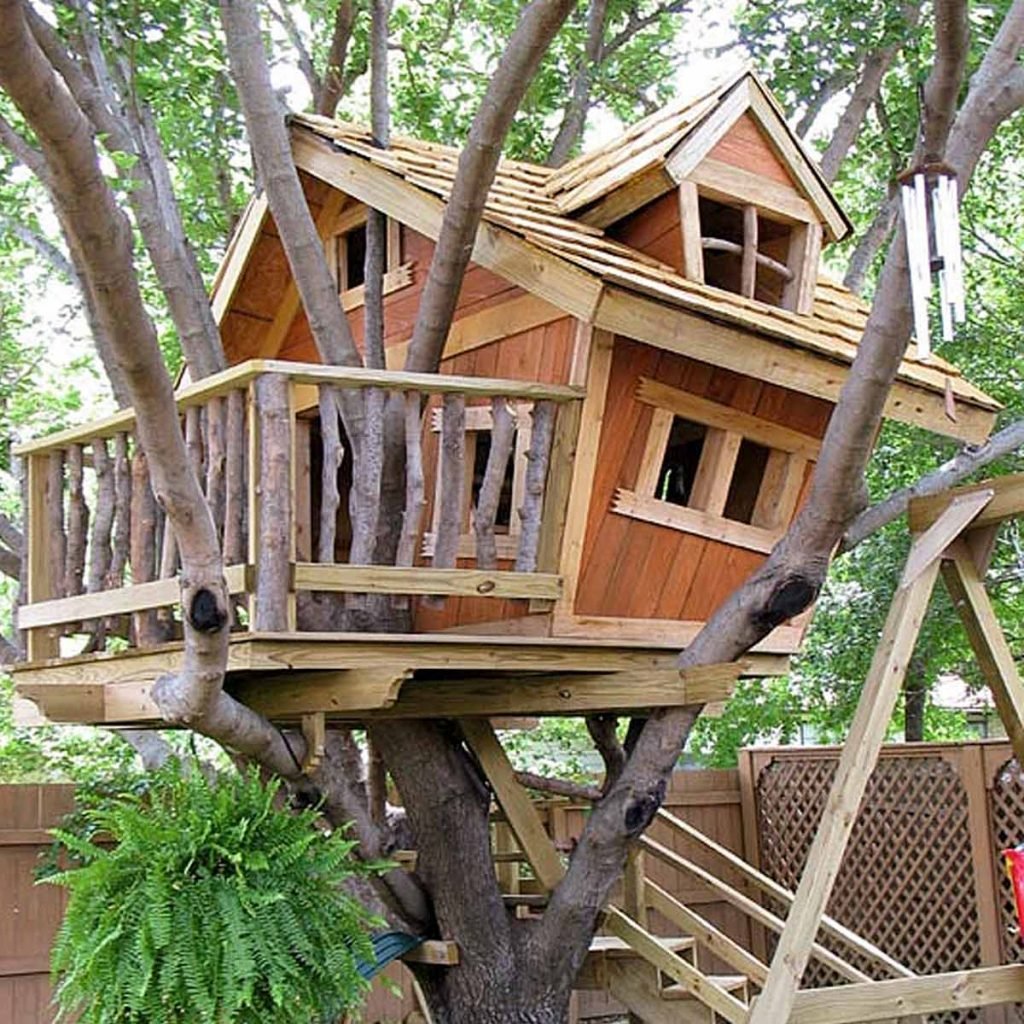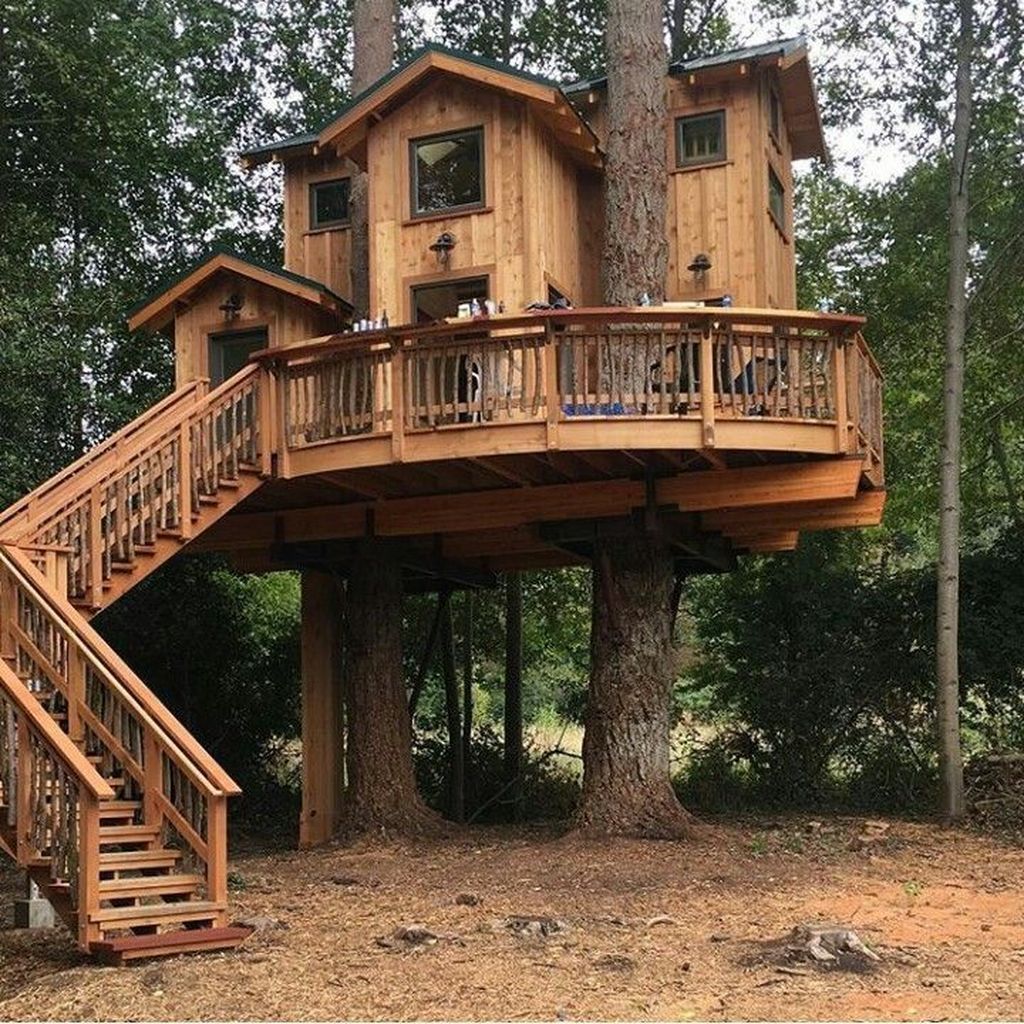DIY Tree House: Building your own tree house is a dream many of us have held onto since childhood. It’s a chance to create a unique and personal space, nestled amongst the branches of a majestic tree, offering a haven from the everyday hustle. This guide will walk you through the process of designing, building, and maintaining your own tree house, from choosing the perfect tree to adding those finishing touches.
Whether you’re looking for a whimsical retreat for your children or a tranquil escape for yourself, building a tree house is a rewarding project that can bring years of enjoyment. This guide will provide you with the knowledge and tools to turn your tree house dreams into a reality.
Introduction to DIY Tree Houses

Building a tree house is a dream that many people have held onto since childhood. It’s a project that allows you to tap into your creativity, connect with nature, and create a unique space for relaxation and adventure. The allure of a tree house lies in its ability to transport us to a world of imagination and wonder.
Tree houses have been around for centuries, evolving from simple platforms built for hunting and observation to elaborate structures designed for living and entertainment. They represent a fascinating blend of practicality and imagination, showcasing the human desire to connect with nature and create unique spaces.
Types of Tree Houses
Tree houses come in various designs, each offering a unique set of features and benefits. The most common types include:
- Platform Tree Houses: These are the simplest and most basic tree houses, consisting of a platform built around a tree trunk. They are ideal for small children and offer a safe and elevated space for play.
- Cabin Tree Houses: These are more elaborate structures that resemble small cabins, often featuring walls, windows, and a roof. They provide more space and privacy, making them suitable for adults and families.
- Lookout Tree Houses: These are designed to offer panoramic views of the surrounding area. They are often built on tall trees and feature large windows or open balconies.
Planning and Design
Planning and designing a tree house is an exciting and rewarding process. It requires careful consideration of several factors to ensure a safe, structurally sound, and aesthetically pleasing structure.
Tree Selection and Assessment
The tree is the foundation of your tree house, so selecting the right one is crucial. Consider the tree’s species, size, health, and location.
- Species: Choose a tree with strong, sturdy branches and a stable trunk. Deciduous trees like oak, maple, and elm are good choices, as they have strong branches and are less likely to be damaged by storms. Avoid trees with brittle branches or those prone to disease.
- Size: The tree should be large enough to support the weight of the tree house and its occupants. It’s generally recommended to have a trunk diameter of at least 18 inches and branches that are at least 12 inches in diameter.
- Health: Inspect the tree for signs of disease, pests, or damage. A healthy tree is essential for a safe and long-lasting tree house. Look for any signs of decay, cracks, or fungal growth.
- Location: Consider the location of the tree in relation to other structures, utilities, and sunlight. Ensure the tree house will not block access to any essential areas or interfere with other activities.
Tree House Design
Once you have chosen your tree, you can begin designing the tree house. Consider the following factors:
- Size and Shape: The size and shape of the tree house should be determined by the size of the tree and the intended use. For example, a small tree house for children might be a simple square or rectangular shape, while a larger tree house for adults could be more elaborate with multiple rooms.
- Access: Plan for safe and easy access to the tree house. This could involve a ladder, stairs, or a rope bridge. The access point should be sturdy and easy to use, especially for young children.
- Features: Consider the features you want to include in your tree house, such as windows, doors, a deck, a slide, or a climbing wall. These features will add to the enjoyment and functionality of the tree house.
- Budget: Determine a budget for the project. This will help you narrow down your choices and ensure you stay within your financial limits.
Blueprint and Sketch
Creating a blueprint or detailed sketch is essential for planning and building your tree house. It provides a visual representation of the design and helps ensure that all components are properly sized and positioned.
A detailed blueprint should include:
- Dimensions of the tree house
- Location of windows and doors
- Placement of support beams and joists
- Details of the access system
- Any other desired features
Consider using a computer-aided design (CAD) program or drafting software to create your blueprint. These tools can help you create professional-looking plans and ensure accuracy.
Building a DIY tree house is a fantastic way to create a unique and whimsical space in your backyard. To complete the experience, consider adding a DIY outdoor shower nearby. This will allow you to cool off after a day of climbing and exploring your treetop haven, making it a truly immersive experience.
Materials and Tools

Gathering the right materials and tools is crucial for a successful tree house construction. It ensures you have everything you need to build a sturdy and safe structure. This section will guide you through the essential materials and tools required for building a tree house.
Choosing the Right Wood
The foundation of your tree house is its wood. Choosing the right type is essential for durability and safety.
- Pressure-treated lumber: This wood is treated with chemicals to resist rot, decay, and insect infestations, making it ideal for the base of your tree house and any parts in contact with the ground.
- Cedar: This wood is naturally resistant to rot and insects, making it a good choice for siding, roofing, and other exterior parts. It also has a pleasant aroma and a beautiful natural color.
- Redwood: Similar to cedar, redwood is naturally resistant to rot and insects. It also has a beautiful reddish-brown color and is very durable.
- Pine: Pine is a softwood that is relatively inexpensive and easy to work with. It is a good choice for framing, floors, and walls.
Other Essential Materials, Diy tree house
Besides wood, you’ll need various other materials for your tree house.
- Fasteners: These include screws, nails, bolts, and lag screws. Choose high-quality fasteners suitable for the wood you are using.
- Plywood: Plywood is used for the floor, walls, and roof of the tree house. Choose plywood that is rated for exterior use to ensure durability.
- Roofing materials: Asphalt shingles, metal roofing, or cedar shakes are common options. Choose a material that is suitable for the climate and the style of your tree house.
- Insulation: Insulation helps to regulate the temperature inside your tree house. Consider using fiberglass insulation, foam board insulation, or cellulose insulation.
- Window and door materials: Choose windows and doors that are appropriate for the size and style of your tree house.
- Hardware: This includes hinges, handles, locks, and other hardware needed for doors, windows, and other features of your tree house.
- Paint or stain: This is used to protect and enhance the appearance of your tree house. Choose a paint or stain that is suitable for exterior use.
Tools and Equipment
You’ll need a variety of tools and equipment to build your tree house.
- Power tools: These include a circular saw, a drill, a jigsaw, a sander, and a nail gun.
- Hand tools: These include a hammer, a screwdriver, a tape measure, a level, a saw, a chisel, a plane, and a wrench.
- Safety gear: This includes safety glasses, earplugs, work gloves, and a hard hat.
- Ladders: You’ll need ladders to access the tree and the construction area.
- Scaffolding: Scaffolding is helpful for reaching high areas of the tree house.
Choosing the Right Tools
The specific tools you’ll need will depend on the design of your tree house and your level of experience.
- Beginner-friendly tools: For a basic tree house, you can get by with a few essential hand tools like a hammer, a saw, a screwdriver, a tape measure, and a level.
- Advanced tools: For more complex designs, you’ll need more specialized tools, such as a circular saw, a drill, a jigsaw, and a sander.
Construction Process: Diy Tree House
The construction process of a treehouse is a rewarding and exciting journey, requiring careful planning and execution. This section will guide you through the essential steps, ensuring a safe and sturdy structure.
Foundation
A secure foundation is crucial for a stable treehouse. Here are the essential steps to ensure a solid base:
- Choose the Right Tree: Select a healthy tree with strong branches that can support the weight of your treehouse. Ensure the tree is at least 12 inches in diameter at the base.
- Prepare the Support Beams: Use pressure-treated lumber for support beams, as they are resistant to rot and decay. The size and number of beams will depend on the tree’s size and the treehouse’s weight.
- Attach the Beams to the Tree: Securely attach the support beams to the tree using heavy-duty lag bolts or specialized treehouse brackets. These bolts should be long enough to penetrate deep into the tree’s trunk.
- Create a Platform: Build a platform using sturdy lumber, supported by the beams. This platform will serve as the base for the rest of your treehouse.
Frame
The frame provides the structural support for the treehouse.
- Construct the Walls: Use 2×4 lumber to create the walls of your treehouse. Cut the lumber to the desired height and length, then join them together using strong wood glue and screws.
- Build the Roof: The roof structure depends on the design of your treehouse. You can choose a simple gable roof, a hip roof, or a more complex design. Use 2×4 lumber for the rafters and plywood for the roof sheathing.
Walls and Roof
The walls and roof are the visible elements of your treehouse.
- Sheathing: After the frame is complete, apply sheathing to the walls and roof. Plywood or OSB (Oriented Strand Board) is commonly used for this purpose.
- Insulation: For added comfort and energy efficiency, consider adding insulation to the walls and roof. Fiberglass insulation batts or spray foam are popular choices.
- Exterior Cladding: Choose an exterior cladding that complements your treehouse design. Options include wood siding, vinyl siding, or even shingles. The choice depends on your budget and aesthetic preferences.
- Roofing: Install roofing materials to protect your treehouse from the elements. Shingles, metal roofing, or even a green roof are all possibilities.
Safety and Regulations
Building a tree house is a fun and rewarding project, but it’s crucial to prioritize safety throughout the process. Safety considerations extend beyond the construction phase and encompass the long-term use of the tree house.
Safety Hazards During Construction
Safety hazards during construction are a significant concern. The most common hazards include falls from heights, improper use of tools, and contact with electrical wires.
- Falls from Heights: Working at heights poses a significant risk of falls, especially when using ladders or scaffolding. Always use proper safety equipment like harnesses and fall arrest systems. Securely anchor ladders and scaffolding to prevent tipping or shifting.
- Tool Use: Improper tool use can lead to injuries. Ensure that all tools are in good working condition, and use them according to manufacturer instructions. Always wear safety glasses and gloves when operating power tools.
- Electrical Hazards: Contact with electrical wires can be fatal. Before starting construction, locate and identify any overhead power lines in the area. Maintain a safe distance from power lines and use insulated tools when working near them.
Building Codes and Regulations
Building codes and regulations vary by location and may apply to tree houses, depending on their size and complexity. It’s important to research and understand the specific codes in your area.
- Permits: In some areas, permits may be required for tree house construction, especially if the structure exceeds a certain size or height. Check with your local building department for specific requirements.
- Structural Integrity: Building codes often address structural integrity, ensuring the tree house can withstand wind loads and other environmental forces. Consult with a qualified engineer if you have any doubts about the structural design.
- Accessibility: Building codes may also address accessibility requirements, such as providing ramps or handrails for people with disabilities.
Safety Tips for Accessing and Using a Tree House
Once the tree house is built, it’s crucial to implement safety measures for accessing and using it.
- Stable Access: Ensure a sturdy and stable access point, such as a ladder or staircase, to reach the tree house. Regularly inspect and maintain the access point for any signs of wear or damage.
- Handrails and Guardrails: Install handrails and guardrails around platforms and openings to prevent falls.
- Supervision: Supervise children when they are using the tree house, especially if they are young or inexperienced.
- Weather Conditions: Avoid using the tree house during inclement weather, such as strong winds, heavy rain, or snow.
Closing Notes
Building a DIY tree house is an adventure that combines creativity, practicality, and a deep appreciation for nature. From the initial planning stages to the final touches, every step is a chance to personalize your space and create a truly unique retreat. Remember to prioritize safety and sustainability throughout the process, and most importantly, enjoy the journey of bringing your tree house vision to life.




